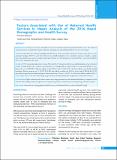Please use this identifier to cite or link to this item:
https://hdl.handle.net/20.500.14356/1403Full metadata record
| DC Field | Value | Language |
|---|---|---|
| dc.contributor.author | Bhattarai, Prithutam | - |
| dc.date.accessioned | 2023-05-10T06:14:51Z | - |
| dc.date.available | 2023-05-10T06:14:51Z | - |
| dc.date.issued | 2019 | - |
| dc.identifier.citation | BhattaraiP. (2019). Factors Associated with Use of Maternal Health Services in Nepal: Analysis of the 2016 Nepal Demographic and Health Survey. Journal of Nepal Health Research Council, 17(3), 301-307. https://doi.org/10.33314/jnhrc.v17i3.1525 | en_US |
| dc.identifier.issn | Print ISSN: 1727-5482; Online ISSN: 1999-6217 | - |
| dc.identifier.uri | http://103.69.126.140:8080/handle/20.500.14356/1403 | - |
| dc.description | Original Article | en_US |
| dc.description.abstract | Abstract Background: Timely access and use of health services are critical for improving maternal health services. The objective of present study is to identify key factors related to antenatal care and institutional delivery services in Nepal. Methods: Data from the Nepal Demographic Health Survey 2016 was analyzed. Women who have taken four or more antenatal checkup (ANC4+), and who delivered at a health Institution were considered outcome variables. Logistic regression analysis was used to compute odds ratio. Women (15-49) having most recent birth in 5 years preceding the survey were included in the study. Results: 69.4% women had taken four or more ANC and 60.6 % had given delivery at a health institution. Age of mother at birth of child, birth order, residence, and ethnicity were significantly associated with use of maternal health service. Educated were 3.79(CI2.83-5.08) times likely to take ANC4+ and 2.71 (CI 2.05-3.57) times likely to give birth at health institution. Richest women were 2.25(CI2.83-5.08) times likely to utilize the ANC4+ service and 9.48(CI6.46-13.91) times likely to give birth at health institution. Women in Province 7 were 3.16(CI2.14-4.67) times likely to utilize ANC4+ service and 2.71(CI 1.83-4.05) times likely to give delivery in health institution compared to women in Province 6. Conclusions: Higher educated and richest women were using antenatal care and institutional delivery compared to less educated. The finding reinforces importance of empowering women with education and improving economic situation. Keywords: Antenatal care; demographic and health survey; institutional delivery; maternal health; Nepal. | en_US |
| dc.language.iso | en | en_US |
| dc.publisher | Nepal Health Research Council | en_US |
| dc.relation.ispartofseries | July-Sep, 2019;1525 | - |
| dc.subject | Antenatal care | en_US |
| dc.subject | Demographic and health survey | en_US |
| dc.subject | Institutional delivery | en_US |
| dc.subject | Maternal health | en_US |
| dc.subject | Nepal | en_US |
| dc.title | Factors Associated with Use of Maternal Health Services in Nepal: Analysis of the 2016 Nepal Demographic and Health Survey | en_US |
| dc.type | Journal Article | en_US |
| local.journal.category | Original Article | - |
| Appears in Collections: | Vol. 17 No. 3 Issue 44 Jul-Sep 2019 | |
Files in This Item:
| File | Description | Size | Format | |
|---|---|---|---|---|
| 1525-Manuscript-12200-1-10-20191114.pdf | Fulltext Download | 245 kB | Adobe PDF |  View/Open |
Items in DSpace are protected by copyright, with all rights reserved, unless otherwise indicated.
